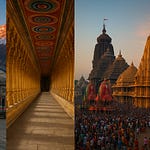Nestled in the bustling heart of New Delhi, Birla Mandir, officially known as the Laxminarayan Temple, is not merely a place of worship — it stands as a historical symbol of social progress, unity, and spiritual devotion. Built during a time of socio-political change in India, this temple intertwines spirituality with a deeper message of equality and national pride.
Foundation and Origin
Conceived by: Ghanshyam Das Birla (G.D. Birla), a noted industrialist and philanthropist.
Foundation Laid: 1933
Completed: 1939
Inauguration: Conducted by Mahatma Gandhi under the special condition that the temple would be open to people of all castes and classes, a revolutionary move at the time.
The temple was built with the dream of creating an inclusive religious space during a period when caste divisions in India were deeply entrenched.
Timeline
The story of Birla Mandir unfolds across several important milestones:
In 1933, the foundation stone for the temple was laid under the vision of industrialist G.D. Birla. The idea was to build a grand, accessible temple that would also reflect India's rich heritage and spiritual ideals.
By 1939, after six years of meticulous construction, the temple was completed. Skilled artisans from all over India contributed to the intricate designs, carvings, and the majestic structure.
In 1939 itself, the temple was inaugurated by Mahatma Gandhi, but only after he secured a historic promise from the Birla family: the temple would be open to people of all castes and classes, without any form of discrimination — a bold and transformative step during that era.
After India's Independence in 1947, Birla Mandir evolved into a symbol of India's modern spiritual movement, representing not just religious devotion but also progressive values of equality, national unity, and social reform.
Architecture and Design
Architectural Style: Nagara Style of Hindu temple architecture.
Material Used: High-quality white marble and red sandstone sourced from Rajasthan.
Spread Over: 7.5 acres with lush gardens, fountains, shrines, and sculptures.
Deities Worshipped:
Lord Vishnu (Narayan) — the preserver.
Goddess Lakshmi — goddess of wealth and prosperity.
Several smaller shrines dedicated to Shiva, Krishna, Buddha, and Durga.
Sculptors and Craftsmen: Artisans from all over India contributed to the temple’s intricate carvings and artworks.
Importance and Symbolism
1. Religious Importance
Dedicated to Lakshmi and Narayan (Vishnu), the temple invites devotees to seek divine blessings for wealth, prosperity, and spiritual well-being.
The temple also represents a synthesis of diverse Indian spiritual traditions by incorporating shrines dedicated to other Hindu gods and Buddha.
2. National and Social Importance
It became a beacon of equality by abolishing caste-based entry restrictions.
It resonated with Gandhian principles of inclusivity.
The temple reflected the Birla family's commitment to philanthropy and social reforms.
Rituals, Pujas, and Aarti
Daily Rituals Include:
Morning Abhishek (Sacred Bathing Ceremony)
Alankara (Adorning of Deities)
Offering of Bhog (Food Offering)
Special Vishnu and Lakshmi Aartis
Evening Bhajans and Kirtans
Aarti Timings:
Morning Aarti: Around 6:00 AM
Evening Aarti: Around 7:00 PM
Special Festivals Celebrated:
Janmashtami (birth of Lord Krishna)
Diwali (festival of lights)
Navratri (dedicated to Goddess Durga)
These festivals attract huge crowds of devotees and the temple is decorated beautifully with lights and flowers.
Bhajans and Spiritual Atmosphere
Devotional bhajans (hymns) praising Lord Vishnu and Goddess Lakshmi are performed daily:
Traditional Sanskrit hymns are recited.
Group Kirtans with musical instruments like dholak, tabla, and harmonium uplift the spiritual energy.
Special Bhajan Evenings are organized during major festivals.
Visiting Birla Mandir: Timings and Information
Opening Hours:
Summer: 4:30 AM to 1:30 PM and 2:30 PM to 9:00 PM
Winter: 5:00 AM to 1:00 PM and 2:00 PM to 8:30 PM
Entry Fee: Free
Photography: Generally prohibited inside sanctum areas.
Dress Code: Modest attire recommended (covering shoulders and knees).
Facilities: Shoe stands, drinking water, restrooms, and gardens for relaxation.
Things to Do at Birla Mandir
Attend the Morning and Evening Aarti for an immersive spiritual experience.
Walk through the temple gardens filled with fountains and sculptures.
Visit the Geeta Bhawan, a hall featuring murals and paintings depicting scenes from the Mahabharata and Ramayana.
Meditate quietly in the peaceful meditation hall inside the temple complex.
Shop at nearby stalls selling religious souvenirs, books, and handicrafts.
Nearby Attractions
While visiting Birla Mandir, you can explore several important places nearby:
Connaught Place: Iconic commercial and shopping center.
Gurudwara Bangla Sahib: Historic Sikh shrine.
Jantar Mantar: 18th-century astronomical observatory.
Rashtrapati Bhavan: Presidential Palace of India.
India Gate: War memorial and symbol of national pride.
How to Reach
Location: Mandir Marg, New Delhi, India
Metro Station: R.K. Ashram Marg Metro Station (Blue Line) is closest.
By Road: Easily accessible by taxis, auto-rickshaws, and buses.
Distance from Airport: About 13-15 km (45 minutes by car).
Best Time to Visit
October to March: Pleasant weather, ideal for sightseeing.
Festive Seasons: Visit during Janmashtami or Diwali to experience grand celebrations and beautiful decorations.
Birla Mandir, Delhi, is not just another temple; it is a living testament to India’s journey towards equality, social justice, and religious unity. Its historic inauguration under the aegis of Mahatma Gandhi, its architectural splendor, and its deep spiritual aura make it a must-visit for devotees, history lovers, and travelers alike.
Visiting Birla Mandir offers not just spiritual solace, but a glimpse into the soul of India, where ancient traditions merge seamlessly with progressive ideals.










